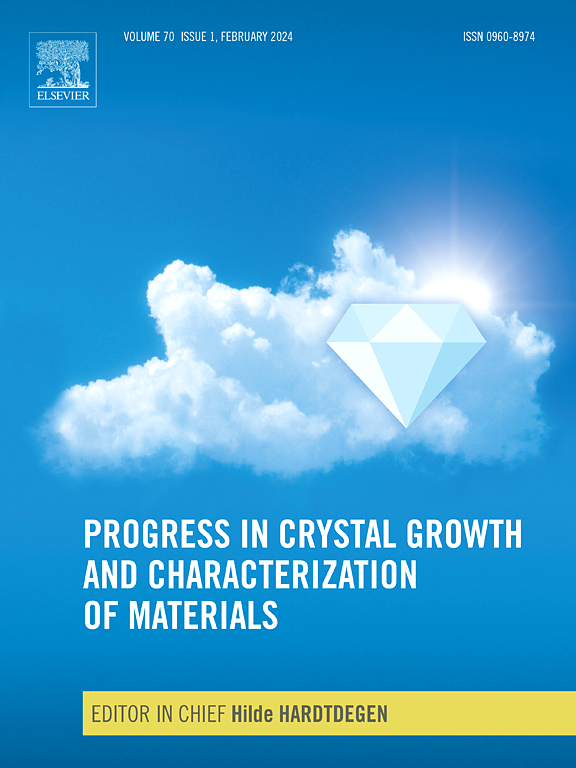固/液界面诱导蛋白结晶
IF 1.9
2区 材料科学
Q1 CRYSTALLOGRAPHY
Progress in Crystal Growth and Characterization of Materials
Pub Date : 2025-07-07
DOI:10.1016/j.pcrysgrow.2025.100676
引用次数: 0
摘要
x射线晶体学仍然是解决生物分子高分辨率原子结构的金标准。其无与伦比的精确度继续提供关键的结构见解,推动药物发现,酶机制阐明,以及生物技术,材料科学和纳米医学领域的分子工程的进步。尽管它有优势,但它的成功从根本上受到对高质量、有序晶体的要求的限制,这是结构生物学的一个持续瓶颈。结晶从成核开始,这是溶质分子组织成稳定核的关键步骤,能够启动晶体生长。控制成核是提高晶体再现性、尺寸和衍射质量的关键。为了克服这一挑战,人们探索了各种界面,包括液/液、空气/水和固/液,其中固/液界面由于其促进和调节成核事件的能力而越来越受到关注。本文系统地讨论了利用固/液界面提高蛋白质结晶效率和质量的策略。它强调了不同表面的作用,包括多孔的、疏水的、带电的、粗糙的和功能化的底物,以及使用微/大颗粒、纳米颗粒和DNA的添加剂辅助成核。静电和非静电表面诱导机制都进行了严格的分析,并对这些表面如何影响成核动力学和晶体生长机制进行了机械见解。对不同表面体系和添加剂体系进行了对比评价,以确定有效的成核促进剂,促进合理的结晶设计。通过加深我们对界面介导成核和生长的理解,本文综述为支持可重复、高通量结晶策略的合理开发提供了全面的知识基础,并概述了结构生物学和结晶科学的未来创新方向。本文章由计算机程序翻译,如有差异,请以英文原文为准。
Solid/liquid interface induced protein crystallization
X-ray crystallography remains the gold standard for resolving high-resolution atomic structures of biomolecules. Its unparalleled precision continues to provide critical structural insights that drive advances in drug discovery, enzyme mechanism elucidation, and molecular engineering across biotechnology, materials science, and nanomedicine. Despite its strengths, its success is fundamentally limited by the requirement for high-quality, well-ordered crystals, a persistent bottleneck in structural biology. Crystallization begins with nucleation, the critical step where solute molecules organize into a stable nucleus capable of initiating crystal growth. Controlling nucleation is essential for improving crystal reproducibility, size, and diffraction quality. To overcome this challenge, various interfaces, including liquid/liquid, air/water, and solid/liquid, have been explored, with the solid/liquid interface gaining increasing attention due to its ability to promote and modulate nucleation events. This review systematically discusses strategies utilizing solid/liquid interfaces to enhance protein crystallization efficiency and quality. It emphasizes the roles of diverse surfaces, including porous, hydrophobic, charged, rough, and functionalized substrates, and additive-assisted nucleation using micro-/macroparticles, nanoparticles, and DNA. Both electrostatic and non-electrostatic surface-induced mechanisms are critically analysed, with mechanistic insights into how these surfaces influence nucleation kinetics and crystal growth mechanisms. Comparative evaluations of different surface and additive systems are presented to identify effective nucleation enhancers and promote rational crystallization design. By deepening our understanding of interface-mediated nucleation and growth, this review provides a comprehensive knowledge base to support the rational development of reproducible, high-throughput crystallization strategies and outlines future directions for innovation in structural biology and crystallization science.
求助全文
通过发布文献求助,成功后即可免费获取论文全文。
去求助
来源期刊

Progress in Crystal Growth and Characterization of Materials
工程技术-材料科学:表征与测试
CiteScore
8.80
自引率
2.00%
发文量
10
审稿时长
1 day
期刊介绍:
Materials especially crystalline materials provide the foundation of our modern technologically driven world. The domination of materials is achieved through detailed scientific research.
Advances in the techniques of growing and assessing ever more perfect crystals of a wide range of materials lie at the roots of much of today''s advanced technology. The evolution and development of crystalline materials involves research by dedicated scientists in academia as well as industry involving a broad field of disciplines including biology, chemistry, physics, material sciences and engineering. Crucially important applications in information technology, photonics, energy storage and harvesting, environmental protection, medicine and food production require a deep understanding of and control of crystal growth. This can involve suitable growth methods and material characterization from the bulk down to the nano-scale.
 求助内容:
求助内容: 应助结果提醒方式:
应助结果提醒方式:


